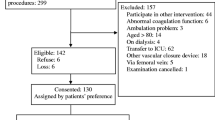Abstract
Objective
Bleeding and vascular access site complications are an important cause of morbidity after percutaneous femoral procedures. New haemostatic dressings have been developed to control heavy bleeding. To evaluate the efficacy of a new kaolin-based haemostatic bandage for femoral artery closure after diagnostic or interventional procedures compared with manual compression.
Methods
The first pilot European trial using this haemostatic bandage was performed at the in Milan, Italy. Two-hundred patients (71% male, mean age 66 ± 11 years) undergoing angiography or PCI via a femoral approach were randomised to the haemostatic bandage (n = 100) or manual compression (n = 100) following sheath removal. The mean active clotting time (ACT) at haemostasis was 146 ± 24 s (range 98–198 s). Haemostasis was achieved in 5.4 ± 1.5 min with the bandage vs 25 ± 15 min after manual compression, p < 0.001. No haemostasis failure occurred in either group. No differences in oozing, minor and major haematomas and pseudoaneurysms were observed. All patients ambulated at 4 h. Major bleeding, re-bleeding or haematoma did not occur after early (4 h after the procedure) ambulation following use of the bandage.
Conclusions
The haemostatic bandage obtained prompt and significantly shorter haemostasis than controls. This novel haemostatic device allowed for early ambulation without clinical complications.

Similar content being viewed by others
References
Starnes BW, O’Donnell SD, Gillespie DL, Goff JM, Rosa P, Parker MV, Chang A (2003) Percutaneous arterial closure in peripheral vascular disease: a prospective randomized evaluation of the Perclose device. J Vasc Surg 28:263–271
Meyerson SL, Feldman T, Desai TR, Leef J, Schwartz LB, McKinsey JF (2002) Angiographic access site complications in the era of arterial closure devices. Vasc Endovasc Surg 36:137–144
Dangas G, Mehran R, Kokolis S (2001) Vascular complications after percutaneous coronary interventions following hemostasis with manual compression versus arterial puncture closing devices. J Am Coll Cardiol 38:638–641
Nasser T, El M, Wilensky R, Hathaway D (1995) Peripheral vascular complications following coronary interventional procedures. Clin Cardiol 18:609–618
American College of Cardiology National Cardiovascular Data Registry, Cardiac Catheterization. Available at: http://www.ncdr.com/webNCDR/NCDRDocuments
Koreny M, Riedmuller E, Nifkardjam M, Siostrzonek P, Mullner M (2004) Arterial puncture closing devices compared with standard manual compression after cardiac catheterization. JAMA 291:350–357
Ahmed B, Piper WD, Malenka D, VerLee P, Robb J, Ryan T, Herne M, Phillips W, Dauerman HL (2009) Significantly improved vascular complications among women undergoing percutaneous coronary intervention: a report from the northern new England percutaneous coronary intervention registry. Circ Cardiovasc Interv 2:423–429
Roguin A, Steinberg BS, Watkins SP, Resar JR (2005) Safety of bivalirudin during percutaneous coronary interventions in patients with abnormal renal function. Int J Cardiovasc Interv 7:88–92
Arnaud F, Teranishi K, Tomori T, Carr W, McCarron R (2009) J Vasc Surg 50:632–639
Arnaud F, Parreno-Sadalan D, Tomori T, Delima MG, Teranishi K, Carr W, McNamee G, McKeague A, Govindaraj K, Beadling C, Lutz C, Sharp T, Mog S, Burris D, McCarron R (2009) Comparison of 10 hemostatic dressings in a groin transection model in swine. J Trauma 67:848–855
Kheirabadi BS, Scherer MR, Estep JS, Dubick MA, Holcomb JB (2009) Determination of efficacy of new hemostatic dressings in a model of extremity arterial hemorrhage in swine. J Trauma 67:450–460
Trabattoni D, Gatto P, Bartorelli A (2010) A new kaolin-based hemostatic bandage use after coronary diagnostic and interventional procedures. Int J Cardiol. doi:10.1016/j.ijcard.2010.10.030
Martin JL, Pratsos A, Magargee E, Mayhew K, Pensyl K, Nunn M, Day F, Shapiro T (2008) A randomized trial comparing compression: Perclose proglide and Angioseal Vip for arterial closure following percutaneous coronary intervention: the CAP trial. Catheter Cardiovasc Interv 71:1–5
Criado FJ, Abul-Khoudoud O, Martin JA, Wilson EP (2000) Current developments in percutaneous arterial closure devices. Ann Vasc Surg 14:683–687
Dauerman HL, Applegate RJ, Cohen DJ (2007) Vascular closure devices. The second decade. J Am Coll Cardiol 50:1617–1626
Politi L, Aprile A, Paganelli C, Amato A, Zoccai GB, Sgura F, Monopoli D, Rossi R, Modena MG, Sangiorgi GM (2010) Randomized clinical trial on short-time compression with kaolin-filled pad: a new strategy to avoid early bleeding and subacute radial artery occlusion after percutaneous coronary intervention. J Interv Cardiol. doi:10.1111/j.1540-8183.2010.00584.x
Author information
Authors and Affiliations
Corresponding author
Rights and permissions
About this article
Cite this article
Trabattoni, D., Montorsi, P., Fabbiocchi, F. et al. A new kaolin-based haemostatic bandage compared with manual compression for bleeding control after percutaneous coronary procedures. Eur Radiol 21, 1687–1691 (2011). https://doi.org/10.1007/s00330-011-2117-3
Received:
Revised:
Accepted:
Published:
Issue Date:
DOI: https://doi.org/10.1007/s00330-011-2117-3




